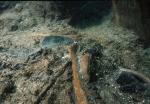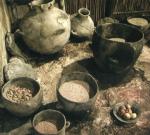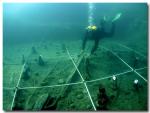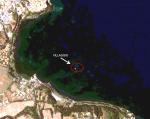Summary (English)
Underwater excavations began at the site of La Marmotta in 1992. This season another series of structures were identified, surveyed and excavation. Eight structures were completely excavated (structures 3, 4+8, 5, 6, 7, 11, 13 and 16), while it was only possible to expose and excavate a minimum part of another six (structures 2, 9, 10, 14, 15 and 17).
Another dugout canoe was recovered (the fifth found at La Marmotta), abandoned on the ancient lakeshore while it was still being made, probably because the hull broke in half.The restoration and conservation of the other dugout canoes was completed: the “La Marmotta 4” dugout, together with wooden artefacts relating to navigation ( a bitt, an oar and a probable board or rudder) has been put on display in the museum’s atrium, in the same large display case as dugout n. 1 and dugout n. 3. Another unfinished dugout broken in several sections was put in the institute’s stores.
The conservation, restoration, and study of the majority of the archaeological materials continued in the Superintendency’s laboratory. A large quantity of containers of various forms, often completely unknown in Italian Neolithic contexts, continue to be reconstructed from the over 65,000 ceramic fragments. The consolidation and conservation of the numerous wooden artefacts, basketwork and cordage, has almost been completed.
Specialists from various institutions are undertaking multidisciplinary analyses on the finds.
The archeozoological remains, over 30,000 elements including various implements, some of which are decorated, are at present being studied and conserved in the Superintendency’s Archaeozoology laboratory.
The few human skeletal remains have been entrusted to the institute’s Laboratory of Physical Anthropology.
The paleobotanical finds are being studied at the Paleobotanical Laboratory at Como Civic Museum.
The micological and pharmacological analyses on several funghi found in the area of the village have been published by the Departments of Agro-environmental Science and technology, Experimental Evolutionistic Biology, and Pharmacology.
Dendrochronological analyses, to date carried out on over 2000 samples (oak and ash), continue at the Italian Institute of Dendrochronology in Verona’s Natural History Museum. The first tree-ring of the dendrochronological sequence of the “Average Curve 1” is dated to around the year 5538 B.C. and the last tree-ring to around the year 5290 B.C.The archeometric analyses of the archaeological materials from the village are being undertaken by the Archaeological Superintendency for Tuscany.
The Department of Earth and Geo-Environmental Sciences at Bologna University is carrying out mineral and petrological analyses on the lithics (about thirty elements – hatchets, axes, pendants, beads and cobbles).
The department of Earth Sciences at Calabria University is studying the numerous obsidian finds. The first results on a small sample show that about 80% come from the island of Palmarola and therefore only the remaining 20% comes from Lipari.
- Maria Antonietta Fugazzola
Director
- Maria Antonietta Fugazzola
Team
Research Body
- Soprintendenza al Museo Nazionale Preistorico Etnografico "Luigi Pigorini"
- Soprintendenza per i Beni Archeologici dell'Etruria meridionale





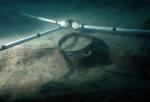
![Download [PDF]](/excavation/skins/fasti/images/results/download_sml.png)
